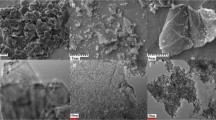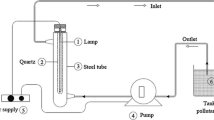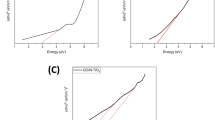Abstract
This work is focused on the synthesis of expanded graphene (EG), polypyrrole-magnetite (PPy/Fe3O4) and expanded graphene-polypyrrole-magnetite nanocomposite (EG-PPy/Fe3O4) electrodes and their application in the degradation of organic pollutants in water. The nanocomposites were synthesized through the co-precipitation method and characterized using ultraviolet–visible spectroscopy, Brunauer–Emmett–Teller surface area analyser, scanning electron microscope, energy dispersive X-ray, X-ray diffractometer and X-ray photoelectron spectroscope. The EG, PPy/Fe3O4 and EG-PPy/Fe3O4 electrodes were applied in a comparative photoelectrochemical degradation of 0.1 × 10−4 M methylene blue (MB) dye and bisphenol A (BPA) in 0.1 M Na2SO4 under visible light irradiation. The degradation was also performed through photolysis, electrochemical and photoelectrochemical processes. The results showed that the pure PPy and EG-PPy/Fe3O4 were present in the Anatase phase of PPy. The EG-PPy/Fe3O4 composite absorbed a noticeable amount of light in the entire visible light region compared to pure PPy and PPy/Fe3O4. The surface area and pore volume of pure PPy was observed to decrease after modification with the EG as a result of the interpenetration of the porous matrix of EG by the PPy nanoparticles. The EG-PPy/Fe3O4 electrode was the most effective in the degradation of both dyes. The order of efficiency was EG < PPy/Fe3O4 < EG-PPy/Fe3O4. The photoelectrochemical degradation process resulted in improved degradation efficiency of 92% (MB) and 88% (BPA) within 240 min and was observed to be greater than that of photolysis and electrochemical oxidation methods. The EG-PPy/Fe3O4 photoanode is regarded as an effective material for the degradation of MB and BPA in wastewater.
Graphical Abstract










Similar content being viewed by others
References
Garg A, Singhania T, Singh A, Sharma S, Rani S, Neogy A, Yadav SR, Sangal VK, Garg N (2019) Photocatalytic degradation of bisphenol-A using N, Co codoped TiO2 catalyst under solar light. Sci Rep 9(1):765
Raizada P, Sudhaik A, Singh P (2019) Photocatalytic water decontamination using graphene and ZnO coupled photocatalysts: a review. Mater Sci Energy Technol 2:510–516
Mohapatra DP, Brar SK, Tyagi RD, Surampalli RY (2011) Occurrence of bisphenol A in wastewater and wastewater sludge of CUQ treatment plant. J Xenobiotics 1(1):e3–e3
Safabakhsh T, Pourzamani H (2016) Removal of bisphenol A from aqueous solutions using magnetic nanoparticles: investigation of adsorption isotherms. Int J Environ Health Eng 5(1):25
Li Q, Pan F, Li W, Li D, Xu H, **a D, Li A (2018) Enhanced adsorption of bisphenol A from aqueous solution with 2-vinylpyridine functionalized magnetic nanoparticles. Polymers 10(10):1136
Orimolade BO, Adekola FA, Adebayo GB (2018) Adsorptive removal of bisphenol A using synthesized magnetite nanoparticles. Appl Water Sci 8(1):46
Abo R, Kummer NA, Merkel BJ (2016) Optimized photodegradation of bisphenol A in water using ZnO, TiO2 and SnO2 photocatalysts under UV radiation as a decontamination procedure. Drink Water Eng Sci 9(2):27–35
Zielińska M, Bułkowska K, Cydzik-Kwiatkowska A, Bernat K, Wojnowska-Baryła I (2016) Removal of bisphenol A (BPA) from biologically treated wastewater by microfiltration and nanofiltration. Int J Environ Sci Technol 13(9):2239–2248
Dinçer AR, Güneş Y, Hanci TÖ, Güneş E, Khoei S (2018) Effects of endocrine-disrupting compounds (bisphenol A and octhyl phenol ethoxylate) on COD removal efficiency. SAR J 1(2):35–41
Hassan MM, Carr CM (2018) A critical review on recent advancements of the removal of reactive dyes from dyehouse effluent by ion-exchange adsorbents. Chemosphere 209:201–219
Aquino JM, Rocha-Filho RC, Ruotolo LA, Bocchi N, Biaggio SR (2014) Electrochemical degradation of a real textile wastewater using β-PbO2 and DSA® anodes. Chem Eng J 251:138–145
Khatri J, Nidheesh PV, Singh TA, Kumar MS (2018) Advanced oxidation processes based on zero-valent aluminium for treating textile wastewater. Chem Eng J 348:67–73
Sandhya S (2010) Biodegradation of azo dyes under anaerobic condition: role of azoreductase. Biodegradation of azo dyes. Springer, Berlin, Heidelberg, pp 39–57
Sudarni DHA, Aigbe UO, Ukhurebor KE, Onyancha RB, Kusuma HS, Darmokoesoemo H et al (2021) Malachite green removal by activated potassium hydroxide clove leaf agrowaste biosorbent: characterization, kinetic, isotherm, and thermodynamic studies. Adsorpt Sci Technol. https://doi.org/10.1155/2021/1145312
Torres RA, Pétrier C, Combet E, Carrier M, Pulgarin C (2008) Ultrasonic cavitation applied to the treatment of bisphenol A. Effect of sonochemical parameters and analysis of BPA by-products. Ultrason Sonochem 15(4):605–611
Ama OM, Khoele K, Anku WW, Ray SS (2019) Photoelectrochemical degradation of 4-nitrophenol using CuO-ZnO/exfoliated graphite nanocomposite electrode. Int J Electrochem Sci 14(3):2893–2905
Singh P, Shandilya P, Raizada P, Sudhaik A, Rahmani-Sani A, Hosseini-Bandegharaei A (2018) Review on various strategies for enhancing the photocatalytic activity of graphene based nanocomposites for water purification. Arab J Chem 13(1):3498–3520
Arsac F, Bianchi D, Chovelon JM, Conchon P, Ferronato C, Lair A, Sleiman M (2008) Photocatalytic degradation of organic pollutants in water and in air. An analytical approach. Mater Sci Eng C 28(5–6):722–725
Jung KW, Lee SY, Lee YJ, Choi JW (2019) Ultrasound-assisted heterogeneous Fenton-like process for bisphenol A removal at neutral pH using hierarchically structured manganese dioxide/biochar nanocomposites as catalysts. Ultrason Sonochem 57:22–28
Yu F, Bai X, Yang C, Xu L, Ma J (2019) Reduced graphene oxide–P25 nanocomposites as efficient photocatalysts for degradation of bisphenol A in water. Catalysts 9(7):607
Neamtu M, Nadejde C, Hodoroaba VD, Schneider RJ, Verestiuc L, Panne U (2018) Functionalized magnetic nanoparticles: synthesis, characterization, catalytic application and assessment of toxicity. Sci Rep 8(1):1–1
Rasheed T, Bilal M, Nabeel F, Adeel M, Iqbal HM (2019) Environmentally-related contaminants of high concern: potential sources and analytical modalities for detection, quantification, and treatment. Environ Int 122:52–66
Tarmizi EZM, Baqiah H, Talib ZA, Kamari HM (2018) Preparation and physical properties of polypyrrole/zeolite composites. Res Phys 11:793–800
Bai L, Li Z, Zhang Y, Wang T, Lu R, Zhou W, Gao H, Zhang S (2015) Synthesis of water-dispersible graphene-modified magnetic polypyrrole nanocomposite and its ability to efficiently adsorb methylene blue from aqueous solution. Chem Eng J 279:757–766
Li Y, Chen G, Li Q, Qiu G, Liu X (2011) Facile synthesis, magnetic and microwave absorption properties of Fe3O4/polypyrrole core/shell nanocomposite. J Alloys Compd 509(10):4104–4107
Li N, Tian Y, Zhao J, Zhan W, Du J, Kong L, Zhang J, Zuo W (2018) Ultrafast selective capture of phosphorus from sewage by 3D Fe3O4@ZnO via weak magnetic field enhanced adsorption. Chem Eng J 341:289–297
Shanehsaz M, Seidi S, Ghorbani Y, Shoja SM, Rouhani S (2015) Polypyrrole-coated magnetic nanoparticles as an efficient adsorbent for RB19 synthetic textile dye: removal and kinetic study. Spectrochim Acta A 149:481–486
Siburian R, Sihotang H, Raja SL, Supeno M, Simanjuntak C (2018) New route to synthesize of graphene nano sheets. Orient J Chem 34(1):182
Guo J, Gu H, Wei H, Zhang Q, Haldolaarachchige N, Li Y, Young DP, Wei S, Guo Z (2013) Magnetite–polypyrrole metacomposites: dielectric properties and magnetoresistance behavior. J Phys Chem C 117(19):10191–10202
Lopez JA, González F, Bonilla FA, Zambrano G, Gómez ME (2010) Synthesis and characterization of Fe3O4 magnetic nanofluid. Revista Latinoamericana de Metalurgia y Materiales 30(1):60–66
Bhaumik M, Maity A, Srinivasu VV, Onyango (2011) Enhanced removal of Cr(VI) from aqueous solution using polypyrrole/Fe3O4 magnetic nanocomposite. J Hazard Mater 190:381–390
Deng J, Peng Y, He C, Long X, Li P, Chan AS (2003) Magnetic and conduction Fe3O4-polypyrrole nanoparticles with core-shell structure. Polym Int 52(7):1182–1187
Sidhu GK, Kumar R (2018). Study the structural and optical behaviour of conducting polymer based nanocomposites: ZrO2-polypyrrole nanocomposites. In: IOP conference series: materials science and engineering 360(1):012038. IOP Publishing
Nezhad AA, Alimoradi M, Ramezani M (2018) One-step preparation of graphene oxide/polypyrrole magnetic nanocomposite and its application in the removal of methylene blue dye from aqueous solution. Mater Res Express 5(2):025508
Sadrolhosseini AR, Abdul Rashid S, Noor ASM, Kharazmi A, Lim HN, Mahdi M (2016) Optical band gap and thermal diffusivity of polypyrrole-nanoparticles decorated reduced graphene oxide nanocomposite layer. J Nanomater 2016:1–8
Acknowledgements
The authors wish to acknowledge the Faculty of Science/PDRF, Department of Chemical Sciences Centre for Nanomaterials Science Research and the University of Johannesburg, South Africa, for their financial support. We also acknowledge DST-CSIR and CENAM, Council for Scientific and Industrial Research, South Africa for making their instruments available for this research.
Author information
Authors and Affiliations
Corresponding author
Additional information
Publisher's Note
Springer Nature remains neutral with regard to jurisdictional claims in published maps and institutional affiliations.
Rights and permissions
About this article
Cite this article
Ama, O.M., Aigbe, U.O., Anku, W.W. et al. Degradation of Methylene Blue Dye and Bisphenol-A Using Expanded Graphene-Polypyrrole-Magnetite Nanocomposite. Top Catal 65, 1745–1754 (2022). https://doi.org/10.1007/s11244-022-01626-1
Accepted:
Published:
Issue Date:
DOI: https://doi.org/10.1007/s11244-022-01626-1




